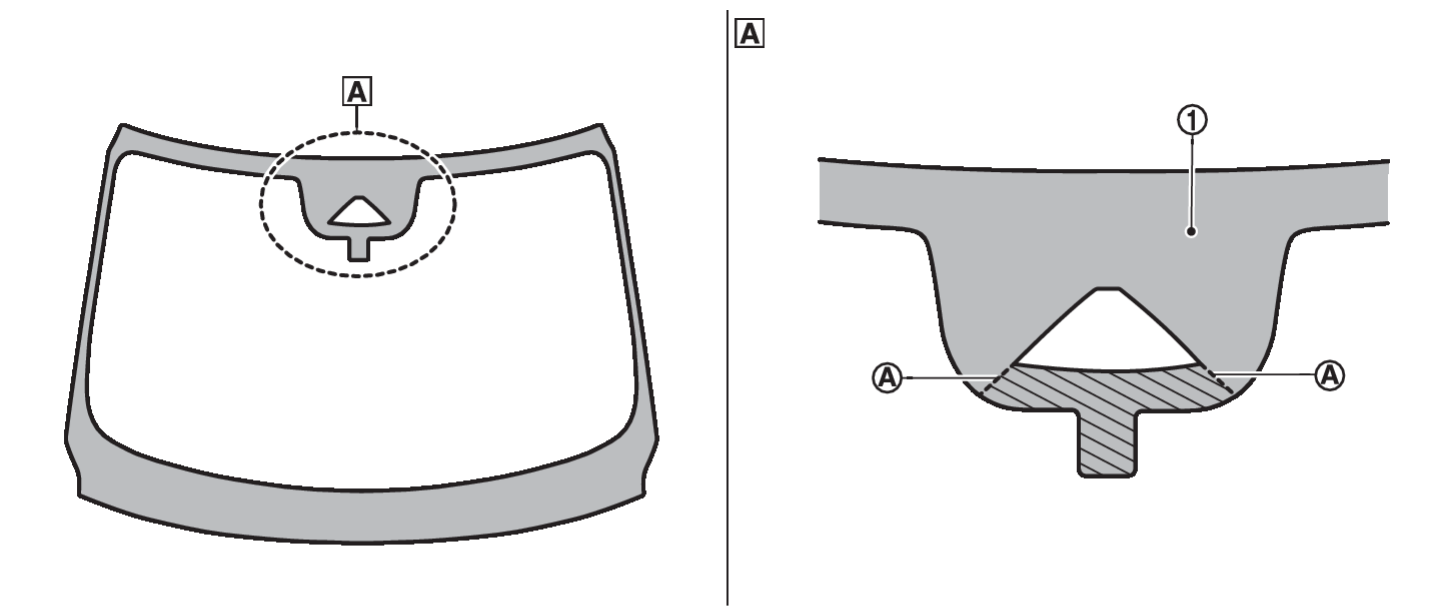Handling Precaution
PRECAUTIONS FOR FRONT CAMERA UNIT
- Always keep the windshield clean.
- Do not attach a sticker (including transparent material) or install an accessory near the front camera unit.
- Do not place reflective materials, such as white paper or a mirror, on the instrument panel. The reflection of sunlight may adversely affect the front camera unit’s capability of detecting the lane markers.
- Do not strike or damage the areas around the front camera unit. Do not touch the camera lens or remove the screw located on the front camera unit.
Replace the windshield glass for operating the system normally, when there is a scratch on the area within the lines extended from notch of windshield upper portion.
PRECAUTIONS FOR LDW
Failure to follow the warnings and instructions for proper use of the LDW system could result in serious injury or death.
- This system is only a warning device to inform the driver of a potential unintended lane departure. It does not steer the vehicle or prevent loss of control. It is the driver’s responsibility to stay alert, drive safely, keep the vehicle in the traveling lane, and be in control of the vehicle at all times.
Listed below are the system limitations for the LDW system. Failure to follow the warnings and instructions for proper use of the LDW system could result in serious injury or death.
- The system does not operate at speeds below approximately 60 km/h (37 MPH) or if it cannot detect lane markers.
- Do not use the LDW system under the following conditions as it may not function properly:
- During bad weather (rain, fog, snow, etc.).
- When driving on slippery roads, such as on ice or snow.
- When driving on winding or uneven roads.
- When there is a lane closure due to road repairs.
- When driving in a makeshift or temporary lane.
- When driving on roads where the lane width is too narrow.
- When driving without normal tire conditions (for example, tire wear, low tire pressure, installation of spare tire, tire chains, non-standard wheels).
- When the vehicle is equipped with non-original brake parts or suspension parts.
- When towing a trailer or other vehicle.
- The system may not function properly under the following conditions:
- On roads where there are multiple parallel lane markers; lane markers that are faded or not painted clearly; yellow painted lane markers; nonstandard lane markers; or lane markers covered with water, dirt, snow, etc.
- On roads where discontinued lane markers are still detectable.
- On roads where there are sharp curves.
- On roads where there are sharply contrasting objects, such as shadows, snow, water, wheel ruts, seams or lines remaining after road repairs. (The LDW system could detect these items as lane markers.)
- On roads where the traveling lane merges or separates.
- When the vehicle’s traveling direction does not align with the lane marker.
- When traveling close to the vehicle ahead, which obstructs the lane camera unit detection range.
- When rain, snow, dirt or object adheres to the windshield in front of the lane camera unit.
- When the headlights are not bright due to dirt on the lens or if the aiming is not adjusted properly.
- When strong light enters the lane camera unit. (For example, the light directly shines on the front of the vehicle at sunrise or sunset.)
- When a sudden change in brightness occurs. (For example, when the vehicle enters or exits a tunnel or under a bridge.)
![[Previous]](../../../buttons/fprev.png)
![[Next]](../../../buttons/fnext.png)



